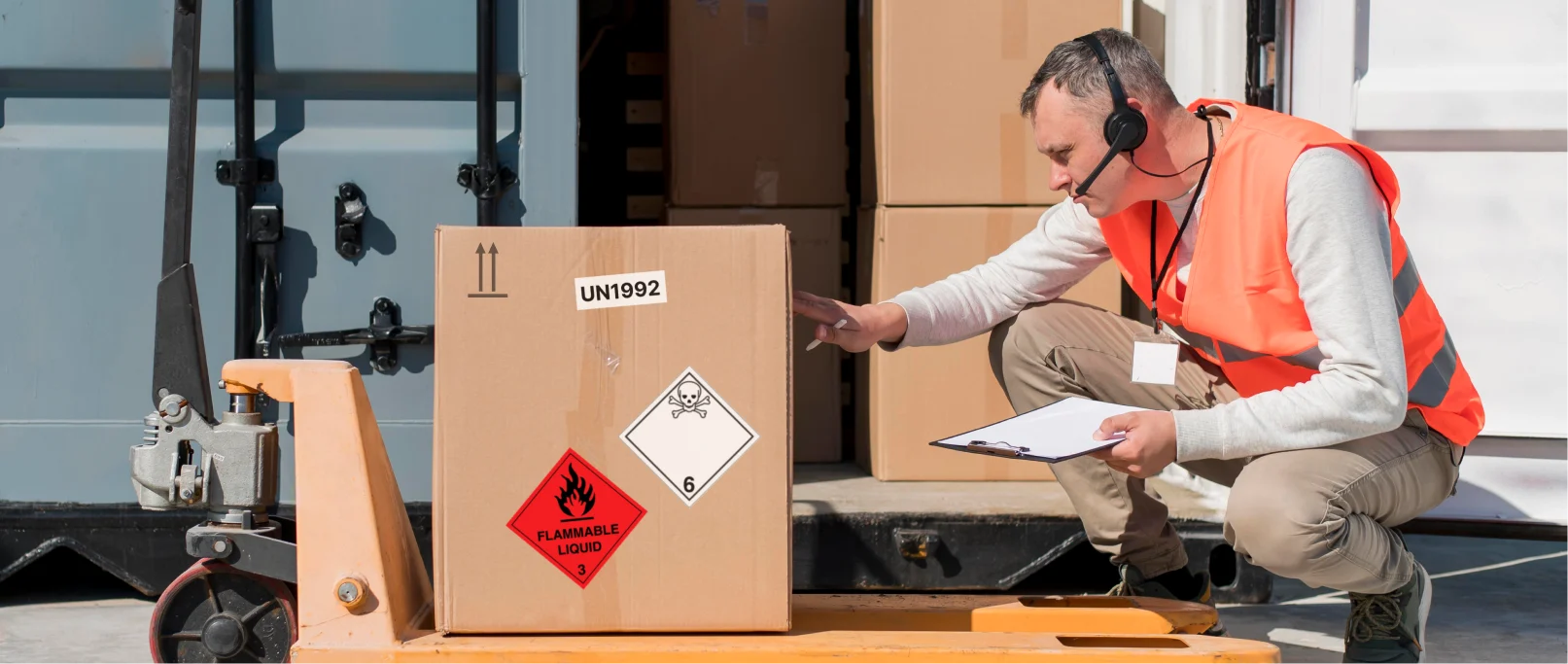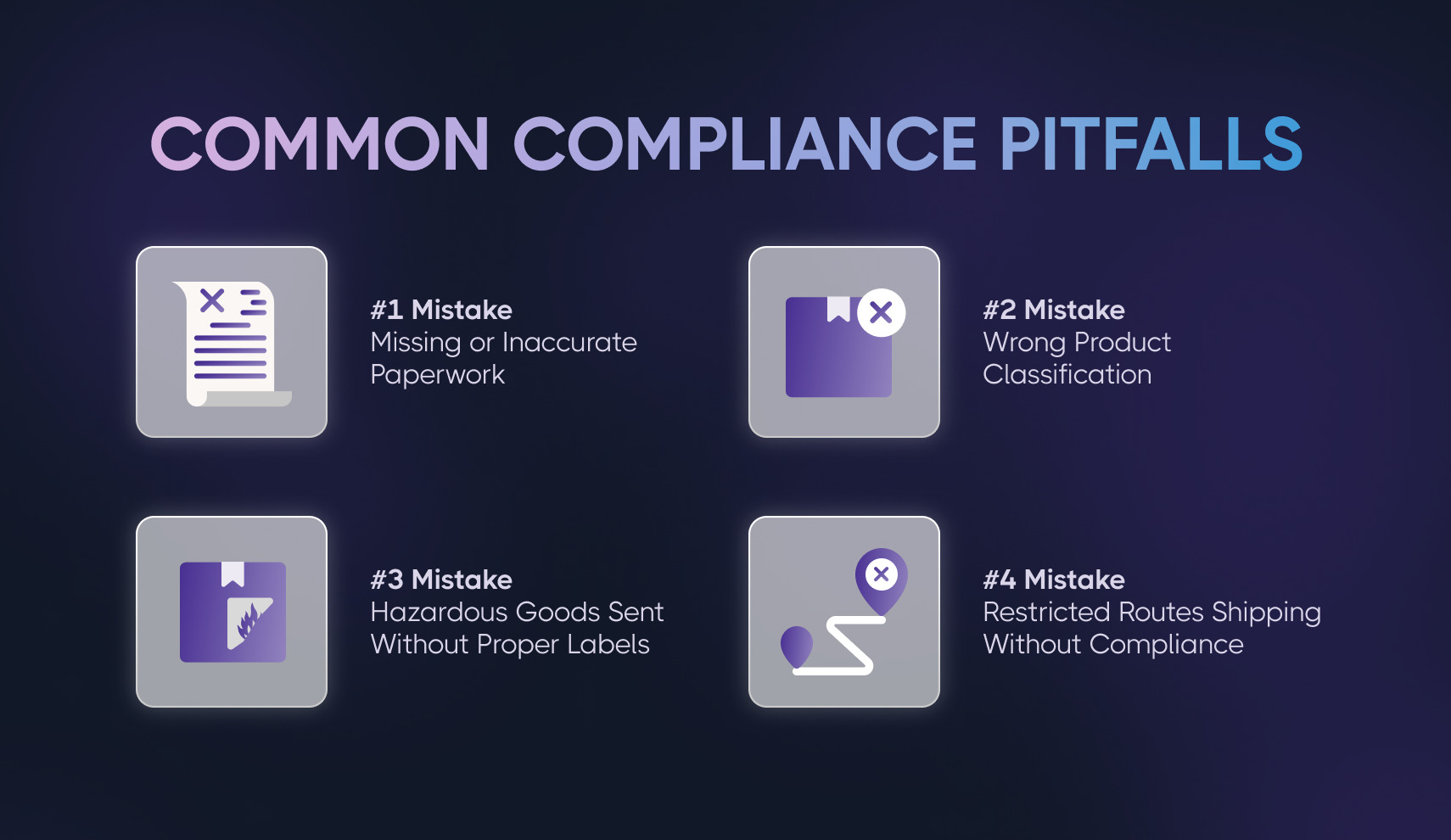
Sahiba Cuccria
8 mins read
9 mins read

Raheel Ladak has over eight years of hands-on freight logistics experience across LTL and FTL networks. He works with businesses to uncover cost-saving opportunities, optimize carrier selection, and streamline cross-border shipping processes for scalable growth.

If you're running an eCommerce business, shipping is one of the biggest touchpoints between you and your customer. But shipping isn't just about moving boxes. It also means navigating complex rules and regulations, especially if you're shipping large volumes, cross-border orders, or shipments that can be categorized as hazmat, restricted or regulated.
Sellers across Canada and the US often overlook compliance until something goes wrong. Maybe a shipment gets flagged at customs. Maybe your package is returned because it wasn’t labeled correctly. Or worse, you’re fined for not meeting hazardous material regulations you didn’t even know existed.
Let’s help you avoid that. This guide will walk you through what shipping compliance means, where sellers typically get tripped up, and how eShipper can help you stay compliant without slowing down your business.
Shipping compliance means adhering to all laws, regulations, and standards governing the transportation of goods across borders and within countries. This includes correctly classifying products, providing accurate paperwork, using approved packaging and labels, and following safety and environmental protocols. Compliance helps prevent costly delays, fines, and damage to your reputation.
Understanding shipping compliance is essential for every seller, whether you ship small parcels or large freight loads, hazardous materials, or standard consumer goods. The complexity can vary, but getting it right safeguards your supply chain and keeps customers happy.
Whether you sell wellness supplements, cleaning products, or lithium-powered electronics, compliance including understanding cross border shipping regulations, is already a part of your business. You may not think about it until a carrier refuses your shipment or a customer complains about delays, but behind every successful delivery is a stack of documentation, standards, and approvals that made it possible.
Shipping compliance means following all local, national, and international regulations when transporting goods.
That includes:
And the risks? They’re real. Non-compliance can lead to:
Customs penalties can range from a few hundred to over $10,000 per shipment, depending on the violation severity.
If you’re shipping from Toronto to New York, or Vancouver to Texas, these rules apply on both sides of the border. The bigger your operation, the more it matters.
Non-compliance impacts more than just timing. When shipments are delayed or returned, it can lead to extra costs for re-shipping and fines that quickly add up. Beyond the financial side, these issues can affect your customers’ experience and trust in your brand. Staying compliant helps you avoid unexpected expenses and keeps your delivery process running smoothly, which is essential for maintaining strong customer relationships and healthy profit margins.

You might think compliance is just for enterprises or freight carriers. But even small online sellers run into problems when they skip the details.
Here are some of the most common issues we’ve seen:
If your product description doesn’t match your invoice, or your HS code is off by even one digit, your shipment can be held at customs. For example, a Montreal-based seller shipping plant-based skincare products to California recently had three pallets delayed for over a week because their commercial invoice lacked a country-of-origin declaration.
HS codes (Harmonized System codes) decide how your product is taxed and treated by customs. A furniture seller in Alberta misclassified a modular sofa as home decor instead of a finished good. That mistake triggered an unexpected 11% duty charge at the US border.
Shipping batteries, aerosols, or industrial supplies? These items may be considered hazardous. A cleaning product distributor in Chicago had an entire skid returned because the UN labels for corrosive liquids were missing. That shipment cost them $800 to retrieve and re-send.
Studies from the U.S. DOT PHMSA shows that nearly 40% of hazardous materials shipments are rejected or returned due to labeling or packaging errors, underscoring the importance of accurate UN labels and proper handling.
If your shipments travel through marine environments or protected zones, like the Great Lakes or coastal ports, there may be environmental restrictions. A seller using a third-party carrier to ship bulk orders from Halifax to Boston found out the hard way when their freight was delayed due to unmet EPA compliance checks.
Let’s break down the main compliance types that matter to sellers shipping within or between Canada and the US:
If you ship detergents, skincare, or any chemical-based products, you need to follow Transport Canada’s TDG regulations or the US DOT’s HAZMAT rules. This means proper classification, Material Safety Data Sheets (MSDS), and specialized packaging.
If you are a seller, then you must remember that If your product contains alcohol, ammonia, or acids, even in small amounts, it likely qualifies as a regulated chemical. Don’t guess. Always verify the classification.
Pro Tip: Always consult the latest TDG and DOT hazardous materials lists before shipping. If uncertain about classification, seek advice from certified HAZMAT professionals to avoid costly mistakes.
Items like power banks, paint, or certain electronics fall under HAZMAT rules. You'll need UN-certified packaging, correct hazard labels, and carrier approval. Training is often mandatory.
For instance, a B2B electronics brand in Ontario now uses eShipper to manage their lithium-ion battery shipments, after multiple rejected loads during peak season.
With eShipper’s HAZMAT support, they’ve reduced their returns to a negligible number.
Pro Tip: Train your staff regularly on hazardous shipping protocols and keep packaging materials stocked with UN-certified labels to prevent last-minute delays.
For sea freight or large shipments, a Document of Compliance may be required to certify the shipment meets international safety and handling regulations. This is standard when exporting heavy machinery or industrial goods.
Pro Tip: For sea freight, obtain your Document of Compliance early in the shipping process to avoid customs bottlenecks at the destination port.
Shipping large orders via LTL or FTL? You must meet carrier guidelines around weight, securing goods, and packaging standards. You’ll also need to ensure your cargo is insured and meets size limits for cross-border transit.
As a real-world example, a retailer shipping gym equipment from Calgary to Michigan saw delays after exceeding axle weight limits for their US-bound trailer.
With eShipper, they now pre-screen every load using our freight audit tools.
Pro Tip: Use freight audit tools to pre-screen your shipments for weight and size limits. This prevents surprise surcharges and ensures timely border crossings.
If your freight passes through regions governed by environmental policies, such as Ontario’s Great Lakes zones or US EPA coastal routes, you may need to use approved carriers with clean emissions certifications.
Pro Tip: Choose carriers with clean emissions certifications for shipments crossing sensitive environmental zones to comply with EPA or Canadian environmental policies.
We know compliance isn’t the most exciting part of your business. But it can make or break your delivery reliability and profit margins. That’s why eShipper gives you built-in tools, checklists, and expert support to keep your shipments compliant without extra admin work.
Here’s how we help:
Our platform flags missing documents, checks for HAZMAT classification, and recommends carrier-approved packaging options.
All our carriers meet Canadian and US regulatory standards. That means you don’t have to second-guess if your shipment meets weight, safety, or customs requirements.
From batteries to chemical samples, we provide packaging advice, labeling guidelines, and documentation templates so your shipment never gets rejected for technicalities.
These are the essential compliance checklists every seller should have
Shipping compliance isn’t just about avoiding problems. It’s about protecting your brand, improving delivery rates, and building customer trust. Whether you're a small eCommerce shop shipping candles from Quebec or a large supplier exporting machinery from Texas, staying compliant helps you stay competitive.
With eShipper, you get more than just shipping tools. You get a logistics partner who understands the rules, catches the risks, and helps your business keep moving forward.
Start with accurate product classification. Your HS code, item description, and country of origin must align across all paperwork.
Look at the product’s ingredients or battery types. If unsure, check Transport Canada or the US DOT website—or ask eShipper’s support team.
Yes. For any LTL or FTL shipments, proper packaging, labeling, and weight documentation is required. A freight audit through eShipper can help.
Some rules, like customs procedures, change annually. Others, such as HAZMAT and environmental protocols, update more frequently. eShipper keeps your process aligned with the latest updates.